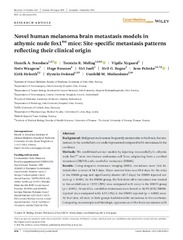| dc.contributor.author | Svendsen, Henrik Aasrum | |
| dc.contributor.author | Meling, Torstein Ragnar | |
| dc.contributor.author | Nygaard, Vigdis | |
| dc.contributor.author | Waagene, Stein | |
| dc.contributor.author | Russnes, Hege Elisabeth Giercksky | |
| dc.contributor.author | Juell, Siri | |
| dc.contributor.author | Rogne, Siril Gudmundson | |
| dc.contributor.author | Pahnke, Jens | |
| dc.contributor.author | Helseth, Eirik | |
| dc.contributor.author | Fodstad, Øystein | |
| dc.contributor.author | Mælandsmo, Gunhild Mari | |
| dc.date.accessioned | 2022-02-23T09:29:26Z | |
| dc.date.available | 2022-02-23T09:29:26Z | |
| dc.date.issued | 2021-10-06 | |
| dc.description.abstract | Background: Malignant melanomas frequently metastasize to the brain, but metastases in the cerebellum are underrepresented compared with metastases in the
cerebrum.<p>
<p>Methods: We established animal models by injecting intracardially in athymic
nude fox1<sup>nu</sup> mice two human melanoma cell lines, originating from a cerebral
metastasis (HM19) and a cerebellar metastasis (HM86).<p>
<p>Results: Using magnetic resonance imaging (MRI), metastases were first detected after a mean of 34.5 days. Mean survival time was 59.6 days for the mice
in the HM86 group and significantly shorter (43.7 days) for HM19-injected animals (p < 0.001). In the HM86 group, the first detectable metastasis was located
in the cerebellum in 15/55 (29%) mice compared with none in the HM19 group
(p < 0.001). At sacrifice, cerebellar metastases were found in 34/55 (63%) HM86-
injected mice compared with 1/53 (2%) in the HM19-injected (p < 0.001) mice.
At that time, all mice in both groups had detectable metastases in the cerebrum.
Comparing macroscopic and histologic appearances of the brain metastases with their clinical counterparts, the cell line-based tumors had kept their original morphologic characteristics.<p>
<p>Conclusions: The present work demonstrates that human brain-metastatic
melanoma cells injected intracardially in mice had retained inherent characteristics also in reproducing interaction with subtle microenvironmental brain tissue
compartment-specific features. The models offer new possibilities for investigating tumor- and host-associated factors involved in determining tissue specificity
of brain metastasis. | en_US |
| dc.identifier.citation | Svendsen, Meling, Nygaard, Waagene, Russnes, Juell, Rogne, Pahnke, Helseth, Fodstad, Mælandsmo. Novel human melanoma brain metastasis models in athymic nude fox1<sup>nu</sup> mice: Site-specific metastasis patterns reflecting their clinical origin. Cancer Medicine. 2021;10(23):8604-8613 | en_US |
| dc.identifier.cristinID | FRIDAID 1965630 | |
| dc.identifier.doi | 10.1002/cam4.4334 | |
| dc.identifier.issn | 2045-7634 | |
| dc.identifier.uri | https://hdl.handle.net/10037/24114 | |
| dc.language.iso | eng | en_US |
| dc.publisher | Wiley | en_US |
| dc.relation.journal | Cancer Medicine | |
| dc.relation.projectID | info:eu-repo/grantAgreement/EC/H2020-EU.3.1.3./643417/France/ERA-NET for establishing synergies between the Joint Programming on Neurodegenerative Diseases Research and Horizon 2020/JPco-fuND/ | en_US |
| dc.rights.accessRights | openAccess | en_US |
| dc.rights.holder | Copyright 2021 The Author(s) | en_US |
| dc.title | Novel human melanoma brain metastasis models in athymic nude fox1nu mice: Site-specific metastasis patterns reflecting their clinical origin | en_US |
| dc.type.version | publishedVersion | en_US |
| dc.type | Journal article | en_US |
| dc.type | Tidsskriftartikkel | en_US |
| dc.type | Peer reviewed | en_US |


 English
English norsk
norsk